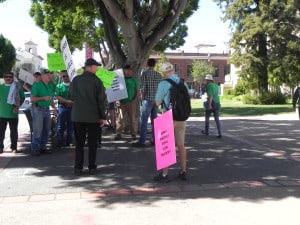Diablo Canyon has friends that value its clean electricity
On March 17, 2016 a group of sign-carrying, green tee shirt clad people gathered in downtown San Luis Obispo to show their support for the continued operation of the Diablo Canyon Nuclear Power Station. Organized by Californians for Green Nuclear Power and Friends of Diablo Canyon, the event was covered by reporters from several local media outlets including the SLO Tribune, KSBY TV-6, the SLO New Times and KCEC AM 920.
Though the group numbered about 20 at any one time, Gene Nelson, one of the organizers and participants, told me that between 40-50 people attended at least part of the 2 hour rally. Participants gathered at one of the busiest intersections in the town and asked for passers by to honk to express their support. There were apparently lots of honks.
The rally gave concerned citizens an opportunity to talk with reporters and to explain some of the obstacles and additional burdens that are being imposed to discourage its owner from continuing to operate the plant.
Even though the plant’s operating licenses are are valid until 2024 and 2025, the first hurdle that can be used to add costs is the expiration of two leases for coastal land from the California Land Commission. In California, the state owns the land up to the high water mark.
The cooling water intake and discharge structures are located on tidal land, so PG&E had to enter into lease agreements with the state. The maximum length of a coastal land lease is 49 years. Because Diablo Canyon’s construction took more than a dozen years, the initial leases will expire several years before the end of the power plant’s 40 year NRC operating license.
Coastal land leases can be renewed, but the process gives the state an opportunity for new demands. It is well within the realm of possibility that the state will ask for a new environmental impact report as a condition of the lease. The process will be costly and adds a small amount of uncertainty about the continued operation of the plant, even before it’s current operating licenses expire.
Another looming financial risk is the implementation of rules associated with the existing once-through-cooling system. Even though the plant’s heat sink is the largest ocean on the planet, there are people who believe that the waste heat discharged from the plant has a harmful impact on the local environment.
Knowing a little bit about biology and ecology, my assumption is that there was a significant change in the immediate vicinity of the intake and discharge pipes when the plant began operating. During the past 30 years of operations, affected plants and animals have adapted to the current conditions. According to sources that live in the area, local commercial fishermen like the existence of the plant and recognize that its impact on the environment is minimal. It’s attractive to some species and not so attractive to others, but the population has adjusted well over the decades.
Cooling towers, often thought of as the “best available technology” to address once through cooling are not without their own environmental impacts. Cooling towers are massive construction projects, requiring the input of a great deal of steel and concrete. They occupy land that would otherwise be available for habitat. Installation would require the plant to be shut down for an extended period of time; large quantities of hydrocarbons would have to be burned to replace the reliable electricity output. There are even local weather impacts associated with cooling towers; coastal California towns have enough foggy days already without assistance from evaporative cooling towers.
From the consumer point of view, cooling towers would add a substantial cost that must be repaid within a relatively short operating period compared to towers installed during initial construction. They would most likely reduce the plant’s power output because the heat sink temperature would be higher than available from cold ocean water and because there would be additional pumps and fans that add to the plant’s house load.
It’s important for people who want to encourage nuclear plants to continue operating and also want more plants to be built to get out into public and express their opinions. We have allowed the opposition nearly free rein for far too many years. Congratulations to all who attended the rally.
If you care about California and favor the continued use of nuclear energy, please visit Save Diablo Canyon and sign up for campaign updates. If you want to write letters but prefer to begin with a sample, please contact me directly and I can send you one or more of various formats for letters to the Lands Commission, the Governor, the Lieutenant Governor, and even a letter designed to be a useful start for children who are interested in action.






Not being a Californian, but having lived there for a time, I wonder how effective a demonstration in San Luis Obispo is. Just thinking a demonstration in Sacramento or the Bay Area would give more bang for the buck.
It’s great the demonstration took place and it would be crazy to shut that plant down.
The anti-nukes have reigned in California for far too many years.
This latest gambit is just a continuation of what happened to Rancho Seco over 25 years ago.
“The anti-nukes have reigned in California for far too many years”
Yep. Which makes SCE’s actions regarding San Onofre ignorant beyond belief. Instead of dotting every “i”, they rolled the dice. And the anti’s jumped at an industry provided opportunity, and won. One wonders if the El Diablo operators realize how important it is right now to run PERFECT plant. It might not be fair to expect perfection out of this plant, but perfection is what is required. Any “accident”, or “incident”, no matter how small, will doom this facility.
@poa
I disagree with that course of action. Gives all the power to the opposition.
Certainly work hard to do excellent work, but do not ignore the importance of establishing public confidence while plant is running well. Invite public, tell them the good news constantly, encourage workers to continue active participation in community, encourage groups like Californians for Green Nuclear Power, Friends of Diablo Canyon, and Save Diablo Canyon to attend public meetings, write letters, expand, demonstrate, etc.
Nuclear plant owners need to look hard at history and recognize that the turtle posture has failed. It’s time to do something different.
You might disagree with that “course of action”, but I find it hard to believe that you doubt the ramifications of NOT pursuing that course of action. You know as well as I do that ANY publicized “problems” with the operation of this plant will be its death knell.
@poa
IF problems are publicized BEFORE successful efforts to shift conversation and public acceptance, you’re possibly correct. My point is nukes should not (cannot?) accept a situation where perfection is the only way to succeed.
You and I both know humans and human designed machinery isn’t perfect. Both can be damned good, but perfection is an impossible standard of performance.
But running a “perfect” plant is prohibitively expensive, which would also be a death knell. Catch 22.
Hey, at least with the 1st option (not running a “perfect” plant), there is a good *chance* that no event will happen and they will be able to remain open. But with the 2nd option (pursuing perfection), there is no chance the plant will survive.
I agree that it is a very bad (infuriating) situation. What’s the solution? To anti nuclear prejudice on the part of the general public and many well-connected political groups? Hell, I dunno. In the past I’ve advocated the industry standing up for itself in court. It’s much like how people turned to the courts in the past, in response to persistent prejudices on the part of the public (e.g., civil rights, gay rights, etc…).
@Rod Adams
I have only one point about the cooling towers. I am sure your point is true about the huge, hyperboloid, natural-draft cooling towers. But the plant (Monticello Nuclear Generating Station*) I worked at had cross-flow cooling towers, which short, and made of wood and fiberglass paneling. They were lucky at the plant, because these towers seldom had to be run during the winter. If they were run in the winter, generally the ice would build-up and a section of the paneling would come down, producing a tremendous crash and a river of cooling water running over the ground. Not a great day, I was happy it never happened when I was there.
As for the local climate changes at the plant, Monticello gained a year-round swan population, some happy fish in the outtake canal (in the winter), some unhappy cold-water fish in the summer, and a few charming snowstorms from the cooling towers in the spring that blanketed the downtown in the a blizzard while the rest of the area was brilliant sunshine.
*A lovely plant to work at, but obviously my views are my own.
This is clearly a political attack on the Diablo plant (as many here understand). It is clear that many of these CA agencies, such as the coastal and/or lands commission, the Air Resources Board, etc., are packed with people opposed to nuclear power (apparently to a greater extent than even fossil fuels). Or, at a minimum, anti-nuclear groups make them selves heard to such bodies (or have influence on them) to a great extent.
How else can you explain threatening to close this plant over hyped seismic issues, or any issues with the local ocean, even though the overall public health risks and environmental impacts of replacing the plant with ~2 GW of fossil generation are clearly orders of magnitude larger. Don’t they even ask themselves such questions? (Probably not.) How else can you explain why I’m not hearing of similar demands on fossil plants that dot the CA costs (such as the ~2 GW Moss Landing plant on Monterrey Bay). (We had similar BS in NY, where they hammered Indian Point in river impacts, but left fossil plants also on the river alone.)
Such agencies should be required to look at the overall impacts of these decisions. I thought they cared about global warming.
Of note is the fact that the Diablo and San Onofre plants generate(d) ~1.5 times as much power as all the solar and wind generation that has been built to date in CA (at enormous expense). Thus, the closure of those two plants will MORE than offset/neutralize all of those efforts. CA will have spent a huge amount of money to replace nuclear with renewable and some fossil, with electricity-sector fossil use actually going UP a bit!
And it’s not like those vast solar and wind plants have no effect on landscapes, environments and habitats; they’re actually worse than other sources in that regard. Has anyone studied the impacts of all those solar and wind farms on land habitats, and how that compares to Diablo’s impact on the local ocean habitat? (In other words, the nuclear vs. renewable comparison, let alone the nuclear vs. fossil comparison?) Why do I doubt it?